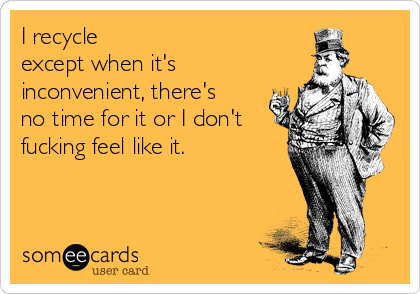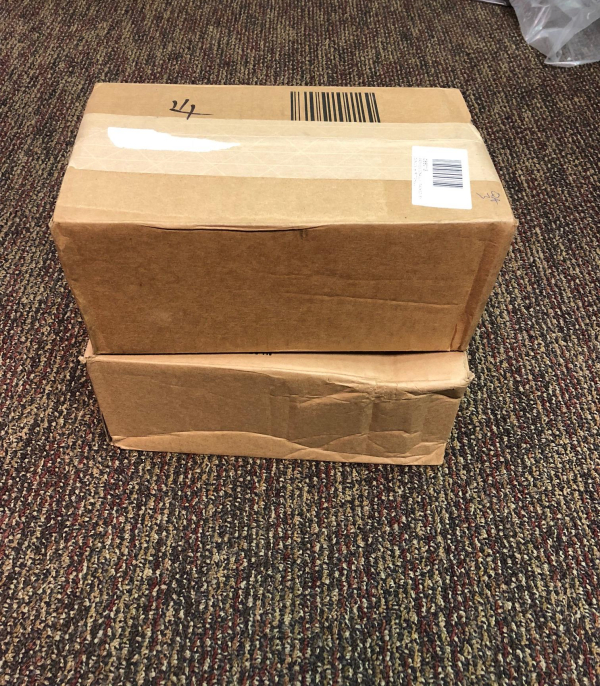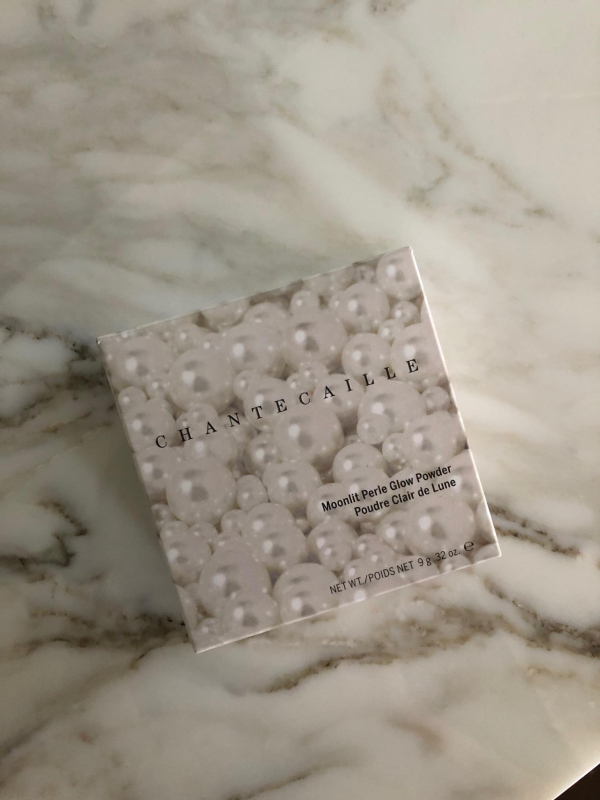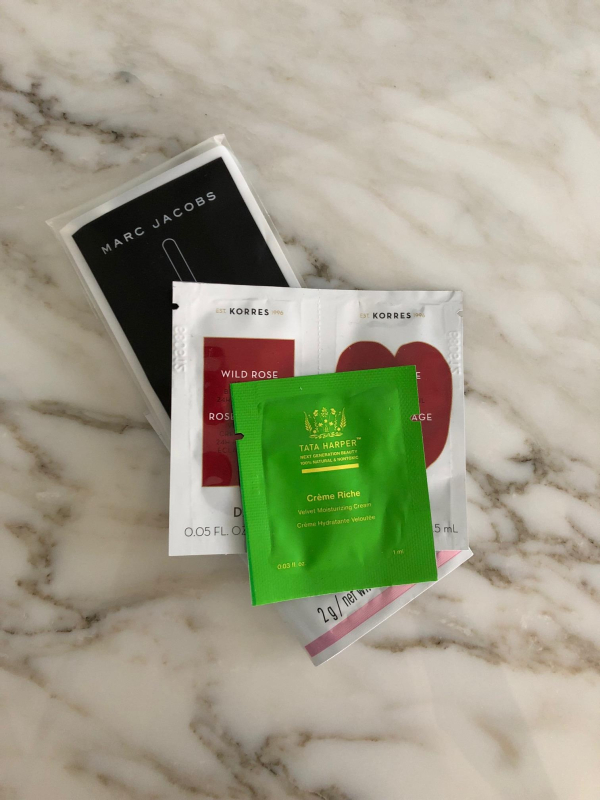Makeup Museum (MM) Musings is a series that examines a broad range of museum topics as they relate to the collecting of cosmetics, along with my vision for a "real", physical Makeup Museum. These posts help me think through how I'd run things if the Museum was an actual organization, as well as examine the ways it's currently functioning. I also hope that these posts make everyone see that the idea of a museum devoted to cosmetics isn't so crazy after all – it can be done!
You might remember my post on MAC's Jeremy Scott collection, in which I responded to the criticism it had received for the packaging being too large and impractical. This in turn led to a rude comment on the blog (which I didn't publish since I refuse to entertain that sort of negativity at the Museum) about how "wasteful" the MAC packaging was, as well as the insinuation that I'm a terrible person for having a makeup collection at all. *eyeroll* While it was a rather nasty attack, I will say it had some value: it got me thinking about packaging waste within the beauty industry and how a makeup museum/collector could cut down on it as much as possible. So as to keep my ramblings to a minimum I'm examining only packaging and not product ingredients and other forms of beauty-related waste.
Let's look at the current problems. Outer packaging for beauty products, due to their fragility and contents, gets to be rather excessive. And consumers are becoming increasingly conscious of beauty packaging waste. One of the biggest packaging hurdles for companies is plastic. According to this article, "most beauty products are swathed in plastic, but only 12 percent of plastic is recycled, which means that eight million tons end up in our oceans every year. By 2050, there will be more plastic in the ocean than fish, and, already, nearly 80 million tons of plastic comprise the Great Pacific Garbage Patch." Also, plastic takes up to 1,000 years (!) to fully decompose. Cardboard is another culprit: "Zero Waste Week, an annual awareness campaign in September for reducing landfill, reports that more than 120 billion units of packaging are produced every year by the global cosmetics industry. The cardboard that envelops perfumes, serums and moisturisers contributes to the loss of 18 million acres of forest each year." This is, of course, to say nothing of the cardboard boxes and packaging used to ship products. I myself shake my head at not only the use of non-recyclable plastic, but the issue of having items from several orders ship separately and in boxes that are much larger than needed. Neiman Marcus is easily the worst offender – recently they sent me boxes this size for one order containing a small item…
…the other huge box was for these tiny samples.
Now I recycle the boxes and paper packaging, but it's pretty ridiculous. I understand no one wants the item to break during transit but there are much more environmentally friendly ways to securely ship items.
Another issue, which I think was mostly what that mean commenter was alluding to, is that the packaging for makeup itself is getting larger and bulkier. As the holiday season rolls in with all its shiny gift sets and palettes, I'm seeing bigger makeup. The size difference isn't noticeably larger when compared only to vintage items – there was a more gradual size increase for every makeup item over the last half of the 20th century – but even in the past 5 years I believe packaging has become larger not necessarily to accommodate more product but to catch the eyes of consumers. Think about it: Not only makeup is physically small, the market is so incredibly saturated companies have to continually up the packaging ante to get people's attention. Some evidence of this super-sizing as an attention-grabber is outlined in quite an eye-opening study published by Fashionista. While it only polled beauty PR reps and recipients (i.e., beauty bloggers and editors) and not plain old consumers like me, the same principles apply to your average beauty customer. One of the most salient excerpts: "While waste abounds in all corners of the industry, responses resoundingly pointed to beauty and skincare brands as the worst perpetrators when it comes to superfluous stuff in mailings. One theory is that there's more pressure to make a big splash with packaging when you're dealing with products that are physically small — a fancy new serum may be just as pricey (and exciting to its new owner) as a pair of shoes, but it doesn't inherently require big, memorable packaging." Not only that, brands are constantly trying to impress bloggers and "influencers" so that they'll be more inclined share their latest collections and products on their social media platforms, so over-the-t0p packaging is slowly becoming the norm. "It's not just an excess of 'normal' packaging items that fashion and beauty people deal with — it's also all the wacky things that may accompany product. Numerous people mentioned single-use video screens that automatically play an ad once the product box is opened as a wasteful novelty that they could do without. 'There is absolutely nothing I hate more than the auto-playing video screens that come in boxes and play obnoxious sounds or video at you without your consent,' wrote one survey-taker. 'It is such a colossal waste of money… and makes me feel annoyed and guilty every time I receive.' Others called out superhero figurines designed to look like them ('what am I supposed to do with that!?'), faux space helmets, neon light-up signs, giant balloon arrangements, a life-size Jenga game and a 'beauty compact' the size of a desktop computer." One recent example from a beauty blogger on Instagram is this gigantic cherry-shaped container for Urban Decay's Naked Cherry collection.
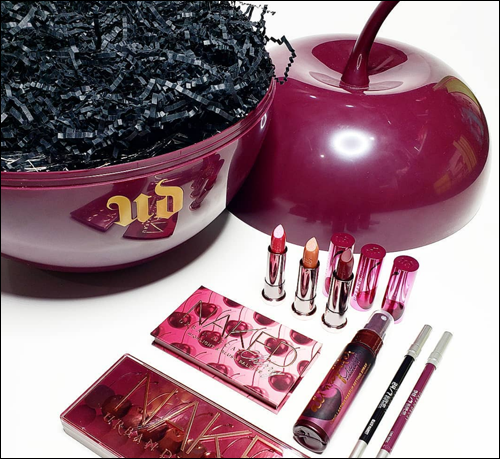
(image from @rubiredlipstick)
And I'm wondering if the "compact the size of a desktop computer" the article refers to is Chanel's enormous PR kit, which contained their new line of glosses. It could be yours for a mere $520.
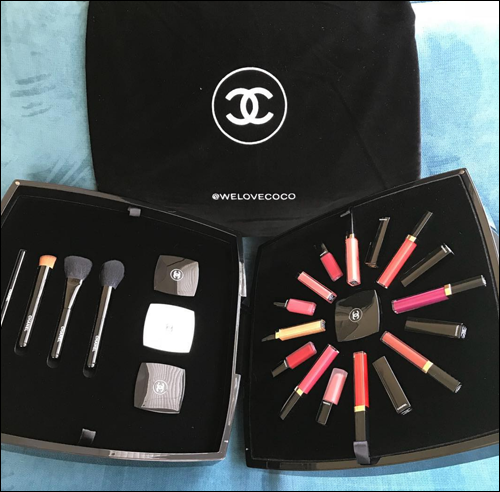
(image from @robinsiegel)
The vast majority of bloggers aren't fellow collectors so I'm assuming they throw out this novelty packaging, which obviously kills me since I'd be ecstatic to keep it for the Museum. Anyway, unfortunately this tactic seems to work, and I have a hunch it's starting to bleed over into the packaging made for regular, non-blogger/editor folks. "'It's become an instance that everyone is looking to stand out, and in order to, we're seeing bigger, more elaborate mailings that grab editors' attention. When our clients see this, they want to do the same or bigger/better to make sure they are seen,' one PR professional wrote. Another editor reluctantly admitted that super-cool packaging did in fact make them more likely to post about the brand, even if they aren't proud of the fact." If this sort of packaging is getting the attention of editors, surely regular consumers would be intrigued too. The other reason for such over-the-top packaging is online shopping, especially in the case of indie brands who don't have a presence in brick-and-mortar stores. "Another responder, who runs a direct-to-consumer brand, mentioned that packaging feels like one of the most significant touchpoints they have with their consumer, since there are no physical stores in which to create a customer 'experience.' In that case, the goal of packaging is to create a moment with the consumer, one which can be prolonged by adding more layers to unwrap or sequins to scoop out of the way."
Now that we have an understanding as to why companies go all out with packaging, the solution seems pretty obvious: switch to sustainable materials. You would think beauty companies could modify their packaging pretty easily, right? Not exactly. Retail space, product preservation and cost are the three main factors that prevent companies from adopting green packaging. Allure magazine explains: "Retailers often put restrictions on package sizing to help maximize shelf space in a store (which makes sense: if they can fit more products on the shelves, they can easily sell more). If a brand wants to sell their product at one of these locations, they have to follow the store’s guidelines when designing their packaging…beauty products are a bit like food. That is, they can go bad (yes, you need to throw away that year-old mascara). That deterioration process goes much faster if a product is not stored correctly. The color, odor, and shelf life of a product are all affected by packaging, and many products need air-tight packaging to stay intact. Many skincare ingredients are finicky (a notorious example is vitamin C). When not properly packaged, the nutritive ingredients that promise to keep you ageless can be destabilized and rendered useless. Of course, as with any business consideration, cost plays a huge factor as well. 'Cheap plastics are exactly that: inexpensive, mass produced and wasteful,' says Lori Leib, the creative director at Bodyography Professional Cosmetics, a company that recently overhauled its products to use half as much plastic and incorporate more recyclable cardboard. 'They do not use good quality materials therefore they are able to make the cost of goods next to nothing,' she says." Alternative green packaging is quite pricey due to the processes involved in making it green, not to mention that some materials (like glass, which is heavier than plastic) would be more expensive to transport. In sum, there are significant obstacles to companies making the switch to eco-friendly packaging.
Fortunately, my complaints and those of other beauty consumers aren't falling on entirely deaf ears. A recent study showed that more consumers are checking products for eco-friendly packaging before making a purchase, and the industry is taking miniscule steps to cut down on excessive, non-sustainable packaging. These solutions include: refillable packaging (see and Kjaer Weis – even their refill packaging itself is recyclable), recycled glass packaging, biodegradable/compostable packaging, with vegetable or soy-based inks used for printing directly onto the package instead of adhesive labels. Another article at Fashionista highlights brands like Alima Pure, which uses food-grade plastic for its jars and recyclable paper to securely pack items instead of bubble wrap, and Ethique, which packages its shower products in compressed bamboo and compostable boxes. Some companies, like LUSH, are forgoing traditional packaging altogether. Their "Naked" line of shower gels and lotions completely do away with bottle packaging. (Personally I find the Naked shower gels to be glorified soap, but at least they're trying.) While there is an increased cost associated with these solutions, many companies are now working it into their regular budgets.
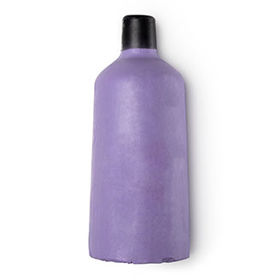
(image from lushusa.com)
So where does all this fit within the context of the Makeup Museum? I think it would be very difficult to have a zero-packaging-waste makeup museum right now. From a consumer standpoint, it's fairly simple to recycle outer boxes and bottles. But if you're trying to preserve makeup items and keep track of them, it's basically impossible to get rid of any extra packaging. The outer boxes are required to offer some measure of protection from fingerprints and minor scratches while the items are in storage, not to mention how they're relied upon for organization purposes – given how vast the collection is now I'd never find anything I was looking for without its clearly marked box. The only thing that would allow a makeup museum be remotely close to zero waste would be if all companies used only biodegradable packaging (or, you know, not having a museum at all, which obviously is out of the question). Efforts are being made to achieve this goal, but we're nowhere near 100% implementation. However, I do think there are small steps I could take to allow for a more environmentally-friendly museum. I've already mentioned the recycling of cardboard boxes and paper packaging for new items so there's that. But if I had a physical space I could probably use the excess packaging, as well as any trash the Museum produced, for visitor-created artwork. Take, for example, the Rubbish Exhibition at London's Science Museum. Artists and staff members collected a month's work of the museum's trash – everything from discarded cutlery and food scraps to old metal signage and brochures – and turned it into an exhibition. After it closed everything got recycled/composted/disposed of through environmentally-conscious means.
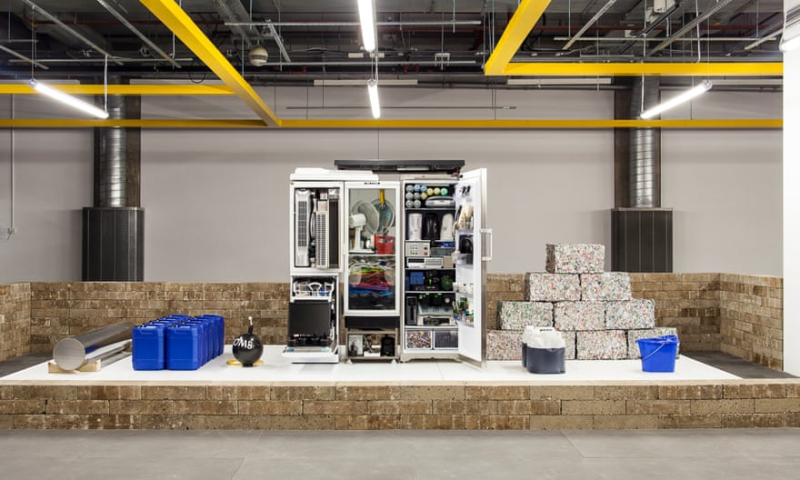
(image from theguardian.com)
Seems pretty genius! In the case of the Makeup Museum, I'd probably have a "waste installation" where people could make their own artwork out of empty makeup containers, or perhaps scribble/paint using expired makeup on a wall of cardboard made from the boxes used to ship the Museum's items. Another idea is to have special exhibitions devoted to eco-friendly beauty lines, or artists who repurpose cosmetics for their work – could you imagine a whole exhibition full Makeup as Muse artists?
Secondly, for vintage items I reuse whatever packaging I have and label it with a post-it note (reusing ones from my office that we no longer can use because the organization's logo is way out of date), or if it the item arrives from the seller in a gift box, I'll write on the box directly to label it. Also, isn't preserving vintage items sort of recycling, in a way? I like to think of it as rescuing items that would otherwise be destined for a landfill.
Third, I think we all need to demand a radical change from beauty companies regarding their current approach to packaging. I've said it before and I'll say it again: consumers have to do their part by being thoughtful about what they purchase and recycle as much as possible, but most of the responsibility for being environmentally conscious lies with cosmetics manufacturers. Consumers can only do so much; I could recycle cardboard boxes till the cows come home and buy less overall, but wouldn't it be so much more helpful for the environment if companies didn't produce excessive, plastic-filled packaging in the first place? As someone who lacks the clout of major beauty bloggers and editors, I doubt my individual voice will be heard, but hopefully the collective masses will start being more vocal about their expectations for companies to use sustainable materials as well as the implementation of recycling programs until they become the norm rather than the exception. As we saw earlier, there are major challenges in switching to green packaging, most notably cost, but I bet consumers would be willing to pay a tiny bit more for product packaging that won't harm the planet. Plus if small indie brands are adopting zero-waste practices, surely the big manufacturers can do it too. I also don't believe that using biodegradable, recyclable materials would drastically limit the type of designs that appear on packaging or their overall style. While I genuinely care about the sad state of our planet (especially the oceans – all that plastic is killing mermaids and their sea creature friends!), I do shudder at the thought of having boring packaging that all looks the same. And I don't like the idea of never having oversize, incredibly fun items like the MAC Jeremy Scott collection. But I really think you can have beautiful packaging (complete with my beloved artist collaborations) using alternative materials. This way I can have my cake and eat it too – even if the packaging is big and splashy, it shouldn't do any long-term damage if it's made out of earth-friendly materials.
What do you think about the current state of beauty packaging? Do you try to reduce the amount of wasteful/environmentally harmful packaging you buy?


